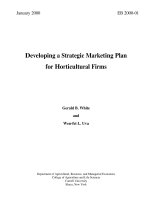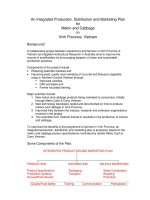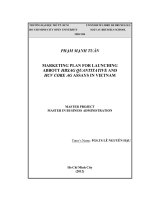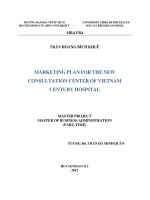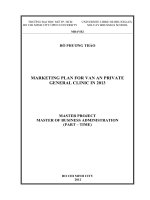Strategic marketing plan for Casumina 2008 to 2010
Bạn đang xem bản rút gọn của tài liệu. Xem và tải ngay bản đầy đủ của tài liệu tại đây (1.36 MB, 59 trang )
2
MINISTRY OF EDUCATION & TRAINING UNIVERSITEÙ LIBRE DE BRUXELLES
HO CHI MINH CITY OPEN UNIVERSITY SOLVAY BUSINESS SCHOOL
MBMM PROGRAM
Huynh Ba Chan Nhu
STRATEGIC MARKETING PLAN
FOR CASUMINA 2008-2010
FINAL PROJECT
MASTER IN BUSINESS & MARKETING MANAGEMENT
Tutor: Dr. Tran Xuan Kiem
Ho Chi Minh City
2007
3
ACKNOWLEDGEMENT OF COMMITMENT
I, Huynh Ba Chan Nhu, have prepared and conducted this “Strategic Marketing
Plan for Casumina 2008-2010” as the final project of MBMM program.
With the approval and keen advices of Mr. Le Van Tri, Sales and Marketing
Director of The Southern Rubber Industry Company and his team, the project
has been accomplished by myself and served the company as a real case.
I trust the legality of all references, information sources, and materials using to
complete the project. And I am confident to submit it to Professors and MBMM
Faculty members.
4
ACKNOWLEDGEMENT OF APPRECIATION
I would like to say thank you so much to many people who have given me helping
hands in this project. Your inputs and encouragement are treasureable for my
project accomplishment.
First of all, I would like to show my great appreciation towards Dr. Tran Xuan
Kiem who has provided me a lot of insightful feedbacks and devoted guidance to
my work. I simply can say, it is a great chance for me to be with you.
I’m also thankful to Mr. Le Van Tri, Sales and Marketing Director of the Casumina
for giving me an opportunity to study about Casumina case and spending your
valuable time giving me a lot of market insights. Next, I’d also like to send many
thanks to Mr. Bui Quoc Long and Mr. Pham Duc Dat, Sales Executives for their
strong supports.
I’d also like to take this opportunity to present my grateful heart to all professors,
lecturers and tutors from the Open University of Ho Chi Minh city and the Solvay
Business School. In the last one and a half year, you have full-heartedly directed us
to the broad path of updated knowledge treasure. Besides, I’d like to present my
deep thanks to the Post Graduate Office and our program coordinators, Ms. Bui
Phan Bao Tran, Mr. Serge Bywalki for your kind supports, and especially Ph.D Le
Thi Thanh Thu for her encouragement at the enrollment stage.
I’d like to convey my sincerely thanks to my classmates and my group who have
shared with me a lot of information and help.
Last but not least, I wish to express my gratitude to my beloved dad, my husband
and the whole family members who give me strength to fulfill the project as well as
the whole program.
6
TABLE OF CONTENTS
Page
ABBREVIATIONS i
LIST OF CHARTS AND TABLES ii
EXECUTIVE SUMMARY
iii
INTRODUCTION
1
CHAPTER 1 ABOUT THE COMPANY
3
1.1 Establishment and achievements 3
1.2 Mission 3
1.3 Corporate goals 4
1.4 Core competency and sustainable competitive advantage 4
CHAPTER 2 SITUATION ANALYSIS
5
2.1 SLEPT Analysis
5
2.1.1 Social factors
5
2.1.2 Legal factors 5
2.1.3 Economic factors
5
2.1.4 Political factors
6
2.1.5 Technological factors
6
2.2 Industry Analysis
6
2.2.1 Market demand
7
2.2.2 Raw material supply
8
2.2.3 Industry capacity and output
8
2.2.4 Export
8
2.3 Competitor Analysis
8
2.4 Company Analysis
11
2.4.1 Strengths
12
7
2.4.2 Weaknesses
13
2.4.3 Opportunities
14
2.4.5 Threats 14
2.5 Customer Analysis
15
2.5.1 Customers’ decision-making process 15
2.5.2 Influencers
16
2.5.3 Purchasing drivers
16
2.5.4 Key success factors
16
CHAPTER 3 MARKETING STRATEGIES FOR AUTOMOBILE
TIRE
17
3.1 Marketing and Product Objectives
17
3.2
Marketing Goals
17
3.3 Segmentation and Targeting
19
3.4 Point of Difference
19
3.5 Positioning
20
3.6 Marketing Strategies for Automobile Tire
20
3.6.1 Market penetration 21
3.6.2 Market share expansion
22
3.6.3 Brand image building
22
CHAPTER 4 MARKETING PROGRAM
23
4.1 Marketing Tactics
23
4.1.1 Product
23
4.1.2 Price
23
4.1.3 Place
24
4.1.4 Promotion
25
4.2 Financial Data and Projection
25
4.2.1 Sales revenue
25
8
4.2.2 Financial projection
26
4.2.3 Budget planning
26
4.3 Implementation
27
4.3.1 Corporate structure
27
4.3.2 Corporate culture 27
4.3.3 Human Resource
27
4.3.4 Marketing program implementation
27
4.4 Evaluation, Monitoring and Control
29
REFERENCES 30
APPENDICES 31
9
ABBREVIATIONS
AFTA
Asean Free Trade Area
ASEAN
Association of South East Asia Nations
BPTO
Brand Price Trade Off
B2B
Business to Business
B2C
Business to Customer
CRM
Customer Relationship Management
DRC
Danang Rubber Company
ERP
Enterprise Resource Planning
FDI
Foreign Direct Investment
GDP
Gross Domestic Product
HCMC
Ho Chi Minh City
ISO
International Organization of Standardization
JIS
Japanese Industrial Standards
MIS
Marketing Information System
OEM
Original Equipment Manufacturer
PNTR
Permanent Normal Trade Relation
R&D
Research and Development
SBU
Strategic Business Unit
SRC
Sao Vang Rubber Company
US
United States
USD
United States Dollar
VND
Vietnam Dong
WTO
World Trade Organization
i
10
LIST OF CHARTS AND TABLES
CHARTS
Page
2.1 Brand Positioning Map 10
2.2 Casumina Distribution System 12
3.1 Ansoft Matrix Model for Casumina 21
4.1 Revenue of Casumina 2000-2010 25
TABLES
2.1 The Number of Registered Vehicles 7
2.2 Capacity versus Consumption of Automobile Tire 8
4.1 Financial Projection 2008-2010 26
4.2 Budget Planning 2008-2010 26
4.3 Marketing Program 28
ii
11
EXECUTIVE SUMMARY
Casumina has had good business on tire and tube production during past years
when the brand knowledge was scarce and not an important component of
success. It was enough to develop a product with right balance of quality and
price, and good distribution. Certainly, the quality, price and distribution are still
highly important factors for success in the marketplace. But today success
requires more. Brand equity and long-term strategic marketing plan count a lot
to sustain a company’s competitive advantage. The Strategic Marketing Plan
has prepared for Casumina to outline analysis on Casumina’s problems,
opportunities, ambitious goals, and actionable programs to enhance its brand
image perception and obtain the leader position in the new automobile tire
market of Vietnam.
The main marketing objectives anchor on intensive growth of radial tire in
domestic market, opportunity search to export automobile tire to other
developing countries, and strong brand building. With the positive growth rate of
the industry, 10% per year, we stretch for the goal of 30% increase in revenue in
the three coming years 2008-2010. And to achieve the goals, we propose the
strategies of horizontal growth for market penetration, general market share
expansion with creating differentiation in after-sale services, customer services
and brand reposition towards “good quality” and “reliable brand” attributes.
In fact, the most difficult strategy of Casumina is to change customers’ prejudice
on Vietnamese goods quality. Therefore, building a new brand concept and
thematic brand building programs for Casumina automobile tire have been
strongly highlighted in this plan. Sub-brand for radial tire is also considered
iii
12
optional in this plan. The message of “international quality standards” is found
key for the brand communication.
Next, price plays an important role in a brand success, especially in B2B
segment. However, it is better to be perceived “cost effective” than “reasonable
price”. In short, the quality and price factors of Casumina automobile tire need
to be in balanced equation, or even better with “value for money” perception.
Thus, research on Brand Price Trade Off and Brand Health Tracking are also
designed in the program to ensure that Casumina has adequate tools to keep
track the market trend.
Moreover, other marketing programs are also very critical for Casumina to gain
leading position in automobile tire market. They are considered as milestones of
Casumina’s strategic planning.
• In line with above the line activities, we giving Casumina a new and
outstanding identity in showroom, point of purchase.
• B2B sales will be more focused for its great contribution to sales and
potential growth.
• Modern tools to improve management like ERP and CRM are on
development. As the market leader, Casumina is actually looking at best
supports to the business development.
• Marketing budget has been raised from 0.5% to 4% of total turnover. More
PR campaign and marketing activities targeting to customers have been
considered in the plan.
13
Furthermore, to implement these programs, Casumina commits to some changes
in terms of organization and corporate values. Firstly, the company is bound to
build professional and specialized teams which have separate functions. Then,
the corporate values will be more customer orientation than sales. But easy said
than done. We all knew that these changes are critical as they are so deep and
wide in an organization and might effect to the resource turnover. However,
they are also found critical for Casumina to sustain in the marketplace
nowadays.
The following parts will help you further understand the business case and how
we plan actions to achieve the goals.
v
1
INTRODUCTION
Today many Vietnamese companies are taking advantage of bilateral trade
agreements like AFTA, PNTR and WTO to expand their business to the
international marketplace. And at the same time, these same trade agreements
are bringing more foreign competition into Vietnam. These foreign competitors
often have decades of branding experience behind them, and more liberal
taxation policies that permit freehanded marketing expenditure. For these
reasons, most of Vietnamese companies have faced a lot of difficulties in
domestic as well as international markets, especially when their operations are
sales driven and almost neglect branding strategies.
The Southern Rubber Industry Company with Casumina brand is one of the
cases. Though the company achieved the revenue of 100 billion US dollar, 40%
share of tire and tube market, and 94% mindshare in 2006, its brand has not yet
been perceived very positive by their customers. Therefore, I have decided to
work on the Strategic Marketing Plan for Casumina 2008-2010 in the hope that I
can contribute some ideas for the Management Board to improve their brand
performance and to succeed in competition.
The Strategic Marketing Plan for Casumina 2008-2010 focuses to promote
Casumina automobile tire products in domestic market which has been
forecasted the most potential and fast growing market in coming years. In this
market, there are currently two main segments: bias tire (suitable for long run,
low speed and poor road condition) and the newly introduced radial tire (suitable
for fast run and good road condition). The radial tire is considered a replacement
2
of bias tire in the future. Therefore, the plan has also given an emphasis on
promoting Casumina’s radial tire products.
The plan is supported by secondary information from desk research and primary
information from two research studies as follows:
- The “Casumina Brand Imagery Assessment” Study was conducted by
Axis Research in January 2006, with 10 in-depth interviews to automobile tire
retailers and a sampling survey of 200 purchasers of transport service companies
in HCMC.
- The “Casumina Brand Health Check” Study was conducted by Axis
Research in October 2006, amongst three actors in the brand decision making
process: retailer (n=100), car/ truck owners (n=100) and drivers (n=240). The
survey covered four main regions: HCMC, Dong Nai, The Central (Hue,
Danang) and Hanoi.
3
CHAPTER 1
ABOUT THE COMPANY
1.1 ESTABLISHMENT AND ACHIEVEMENT
From a state owned company having been established since 1976, the Southern
Rubber Industry Company (Casumina) became a Joint-Stock Company in 2005.
The company has 7 factories and 2500 employees. Casumina is now the largest
tire and tube producer in Vietnam, with the turnover of 100 million US dollar in
2006 and 40% share of Vietnamese tire and tube market. Casumina is also a
partner in a joint venture with Yokohama (Japan) and Continental (Germany).
More than past 30 years, Casumina has got several significant achievements. In
particular, for years Casumina has been largely voted by consumers as a
Vietnamese High Quality Goods Producer, and it continuously improves its
production standard with ISO 9001-2000 management. Furthermore, with the
newly invested assembly lines of radial tire in 2003, it became the first local
producer introducing radial tire into Vietnamese marketplace in 2005.
Especially, Casumina ranks 69 amongst 75 top tire and tube producers in the
world, being one of the only three producers ranked in ASEAN. By any
standard, this is a great success of Casumina.
1.2 MISSION
Casumina commits to be a reliable companion to drivers. The company is driven
towards high international standard of quality but affordable price to
Vietnamese customers. And more importantly, the company strives for the top
Vietnamese brand in terms of awareness and quality perception.
4
1.3 CORPORATE GOALS
In the coming years, Casumina aims to achieve the following major goals:
Non-financial goals:
1. To maintain the leadership in the tire production industry of Vietnam.
2. To promote to higher rank in top 75 tire producers in the world by
considerably increasing its turnover.
3. To support and control up to retail outlet level in order to maximize sales
volume and to ensure consistently strong brand exposure.
4. To leverage the brand image so that the company can tap into a more
premium segments of the market.
Financial goals:
1. To capture a turnover growth of 20%-30% per year.
2. To obtain a return on equity of 30%.
1.4 CORE COMPENTENCY AND SUSTAINABLE COMPETITIVE
ADVANTAGE
- With the long history of establishment, Casumina has strengthened itself
with profound know-how, rich experience, and nationwide distribution network.
- Casumina provides the local market acceptably good quality products at
affordable price.
- Casumina is also an entrepreneur in the local market by introducing radial
tires and pre-empting competitors in this segment.
- Technology advance is another competitive advantage of Casumina to
sustain in an increasing competition environment in the next coming years.
5
CHAPTER 2
SITUATION ANALYSIS
2.1 SLEPT ANALYSIS
2.1.1 Social factors
- Vietnam has a large population, over 83 millions; about 50% of households
earn more than USD 1,000. (Appendix 1)
- The fast industrialization and improving Vietnamese living standards lead to
high social mobility, i.e. the expenditure on transportation is getting higher.
- Consumer patterns have changing, customers begin to demand the lifestyles
associated with modern technology, convenience and comfortability, e.g. better
transportation service.
2.1.2 Legal factors
- Distribution of tire is not open to foreign companies until 2012.
- Ongoing reforms to the bureaucracy in Vietnam, in a bid to speed up the
approval regime for foreign investors and make it more transparent.
2.1.3 Economic factors
- Vietnam has been one of the fastest – growing economies in Asia over the
past five year, average growth of 7.5% per year. Real GDP growth (percentage
change from a year earlier) is estimated at 7.7% in 2007. (Appendix 2)
- The opening up of its own market will bring mixed blessing for Vietnam.
Cheaper imports and increased competition will reduce inflation, which is
currently running at 7.7%, and thus increase purchasing power for Vietnamese
consumers.
6
- Investment, together with consumption, is key driver of Vietnamese growth.
Investment grew in real terms by 19.3% and FDI inflows by 10.6% in 2005.
- The economic boom has lifted many Vietnamese out of poverty, with the
official poverty rate in the country falling from 58% in 1993 to 20% in 2004.
- Vietnam has fully joined WTO in early 2007, i.e. more chances to exports
tire products to other countries in the world.
- Vietnam is in the trend of fast urbanization and infrastructure development,
which facilitates the increase of vehicles, especially cars. (Table 2.1, page 9)
2.1.4 Political factors
- The government appears determined to push ahead with the market oriented
reforms necessary to double 2000’s GDP by 2010, as targeted.
- The government shows to work more efficiently and effectively, with the
obviously seen red tape cut off to attract more foreign investment.
- Relations with the US are improving with the event of Vietnam gaining the
Permanent Normal Trade Relation (PNTR) in late 2006.
2.1.5 Technological factors
All tire producers move from bias-ply to radialization. Bias tire now remains as a
niche market in developed countries.
2.2 INDUSTRY ANALYSIS
For the industry analysis, we dig into different layers that have impacts on the
industry growth, as follows:
1. Market
demand
2. Raw material
3. Industry capacity
4. Industry output
5. Import
7
2.2.1 Market demand
Table 2.1
Automobile registration
The number of vehicles in Vietnam
2003 2004 2005 2006
Total 461,000
528,500
602,000
700,000
1 Passenger car =< 9 seat 137,200
178,200
209,000
250,000
2 Mini-bus 1 10-16 seat 47,600
42,600
47,000
52,000
3 Mini-bus 2 17-25 seat 10,000
7,700
8,000
9,000
4 Bus > 25 seat 21,800
21,700
25,000
29,000
5 Light truck =< 2 ton 50,200
79,800
95,300
119,000
6 Truck > 2 ton 116,800
118,000
130,500
150,000
7
Special purpose
vehicles 49,200
55,500
58,200
60,000
8 Others 28,200
25,000
29,000
31,000
Source: The Office of Transport Registration – Vietnam (2006)
As illustrated in the above table, the number of vehicles in Vietnam increases
every years, e.g. by 16% in 2006 compared to 2005. And according to the survey
conducted among 204 transportation service companies in Jan 2006, most of the
automobile owners (87% of the total) would replace with the new tire when the
current hemp liner is worn out, and about three fourths (76% of the total) do the
replacement every 6-12 months. (Appendix 3). This certainly results in the
greater demand for tire year by year.
The growth rate of Vietnamese automobile market is estimated around 10% in
2007 (versus the world growth rate of 3%) and will be even greater in the
coming years for the following reasons:
- Automobile import tax rate declines from 100% to 80% in 2007.
- The government has policy to expand the infrastructure network.
- Power of car purchase among Vietnamese customers is stronger due to
the economy growth. (Appendix 4)
8
2.2.2 Raw material supply
The supply of natural rubber in Vietnam seems to be abundant, 600,000 tons
whereas rubber industry only consumed 70,000 tons in 2006. In addition, a lot of
raw materials still have to be imported from oversea. (Appendix 5)
2.2.3 Industry capacity and output
When producers all over the world move to radialization from bias-ply,
Vietnamese producers fail to meet the market demand of radial tire, the local
capacity is just 38% of the total consumption. Casumina is the only domestic
producer of radial tires with 50,000 pieces in 2006.
Table 2.2
Capacity versus Consumption of Automobile Tire
Capacity
Total
consumption
Local supply Import
Radial tires 500,000 1,312,000 50,000 1,262,000
Bias tires 3,800,000 2,100,000 1,650,000 450,000
Source: The Office of Statistics and Customs – Vietnam 2006
2.2.4 Export
With high capacity, Vietnam exported automobile tires overseas up to 260,000
pieces of bias tire in 2006. Casumina accounted for 60% of the total export
volume (180,000 pieces of bias tire).
New investors like Kumho and Chengshin expect to export 95% of their
production to oversea. This is obviously a common trend of other well-known
tire producers that they move their factories to developing countries like
Vietnam and other Asian countries (Thailand, Indonesia and China) and back
import products to developed countries.
2.3 COMPETITOR ANALYSIS
Casumina is just on par with Danang Rubber Company (DRC) in terms of
automobile tire’s output volume in 2006. (Appendix 6)
9
The findings of the nationwide survey conducted among three actors (retailers,
owners and drivers) in early 2006 show that DRC is apparently the direct
competitor of Casumina across regions on availability, brand awareness, levels
of selling (retailer), buying (owner) and using (driver). (Appendix 7, 8, 9)
- DRC has the same retail coverage with Casumina (78% versus 79%).
- DRC is just right behind Casumina on all levels of brand awareness in
general and in particular HCMC, Hanoi and Dong Nai. Located in Danang, DRC
is obviously dominating the Central regions (Hue & Danang) on all
measurements; it gains even higher brand awareness and purchase levels than
Casumina. (Appendix 10)
- In addition, DRC especially appears leading in bias segment with high brand
awareness among retailers, high purchase levels among owners. (Appendix 11,
12)
- DRC also gains higher conversion rate from ever purchase to most often
purchase compared to Casumina among owners (57% versus 44%).
- Similarly, DRC is almost on par Casumina on most often usage level among
drivers in Hanoi. (Appendix 13)
- Last but not least, DRC is also perceived slightly better Casumina on “quality
attributes” (durable, takes long to be worn out). (Appendix 14). This is probably a
critical reason for owners tentatively to be more loyal to DRC than Casumina.
(Appendix 15)
While the segment of bias tire is clustered with local brands like Casumina,
DRC and Sao Vang Rubber Company (SRC), the other one of radial tire is
dominated by well-known foreign brands like Bridgestone, Michelin,
Chengshin, Yokohama, Kumho, Goodyear and Hankook.
- SRC obtains even higher brand awareness than Casumina among retailers
and drivers in the Central. (Appendix 16)
10
- The above mentioned foreign brands are especially main threats to
Casumina’s growth in the segment of radial tires with higher availability,
selling, buying and using levels than Casumina among retailers, owners and
drivers (Appendix 17, 18, 19). Moreover, these brands are also better associated
with “quality” and “prestige” attributes than Casumina.
Michelin and Bridgestone clearly have similar positioning as they
both are well-perceived of “reliable”, “well-known”, “consistent quality” and
“technology advanced” brands.
Yokohama, Hankook and Chengshin seem to be close to each others
in terms of positioning. They all have been associated with positive attributes
such as “durable”, “high safety”, “smoothly run”, “reliable”, “consistent quality”,
technology advanced”, “wide range” and “popular brand” by either retailer,
owners or drivers.
Chart 2.1
Brand Positioning Map - Owners
Row profiles and Column profiles on axes 1 and 2 (78% )
Casumina
SRC
DRC
Yokohama
Hancook
Brigestone
Chengsing
Micheline
Nice packaging
Deep hemp liner
High durability
Wide availability
High safety
Fuel economical
Smoothly run
Grip the road w ell
Little thermogentic
Good loading capability
Consisten quality
Reliable brand
Cost eff ective
Advanced technolgy
Reasonable price
Recommended by sellers
Prestigious brand
Good customer services
Fast, good maintenance service
Good brand publicity/
advertisement
Has many attractive promotions
Suitable to Vietnamese w eather &
road condition
Diversified types/ sizes
-0.3
-0.25
-0.2
-0.15
-0.1
-0.05
0
0.05
0.1
0.15
0.2
0.25
-0.7 -0.6 -0.5 -0.4 -0.3 -0.2 -0.1 0 0.1 0.2 0.3 0.4
axis 1 (60% ) >
axis 2 (17% ) >
11
2.4 COMPANY ANALYSIS
2.4.1 Strengths
- Management: Casumina’s management has successfully captured the
market trend and its opportunities. It has had a right and in-time strategy to
change the product focus from motorcycle to automobile tire since 2000.
- Technology/Know-how: Casumina has solid experience and technology in
manufacturing tire especially for Vietnam’s weather and road condition.
Casumina invested 100 billion dong in JIS for radial tire production in 2003 in
order to pre-empt other competitors and meet the market demand. Casumina
also has the best laboratory in rubber industry in Vietnam.
- Offerings: Casumina’s product strategy used to work on price base and
economy of scale. Casumina is therefore well-perceived of “reasonable price”.
As the market leader, Casumina now tentatively levers its price. It currently sets
its price on par with its direct competitor-DRC on most of its products and even
higher price than DRC on some particular products that Casumina leads ahead in
terms of quality and technology. Its price however remains lower than foreign
competitors, Michelin and Bridgestone by 20-30%. Besides, Casumina has
provided customer services like replacement and maintenance.
- Branding: Casumina automobile brand has inherited its good imagery from
its umbrella brand in motorcycle as a mass and leading brand. This is apparently
a competitive advantage of Casumina in automobile tire market.
- Distribution: Similarly, since its launch in 2000, Casumina automobile tire
has benefited from its nationwide distribution network. Casumina has organized
the best distribution network in Vietnam compared to all other competitors,
including 90 distributors and wholesales across Vietnam; thousand of specialty
stores are developed, offering a spectrum of maintenance service. From the
research findings, Casumina appears to have the most effective distribution
12
network as it has highest availability (78%, nationwide), especially in the South
East (97%) (Appendix 7).
Casumina follows a geographical distribution strategy and control up to
wholesale level, as follows:
Chart 2.2
Casumina Distribution System
Flow of sales Horizontal commercial transaction
Overall, Casumina sales’ distribution has been assessed highly effective.
Casumina has cleverly taken advantage of the distribution network which is
developed by distributors, sales agents and wholesalers, as such Casumina has
established long-term relationship with partners, saved cost on sales personnel
and found opportunities to further distribution expansion.
- Marketing and Sales supports: Also from the research findings, Casumina
is well-associated with good marketing and sales support activities to all three
actors (retailer, owner and drivers) such as: good after –sales services, regularly
updates knowledge about products and market, continuously have attractive
promotion, good brand advertising and publicity, good sales supports. (Appendix
14, 16, 20). In terms of brand most often selling/ buying and using, Casumina
gains the highest score, 34%, 29% and 30% respectively. (Appendix 7, 8, 9).
Casumina
HCMC (29%) &
South East
(13%)
Mekong Delta
(5%)
, Central
(13%)
and North (40%)
Showroom
Sales
agents
Wholesalers at
Tan Thanh
Retailers
Customers
Retailers
Distributors
13
Casumina also proves itself a dominant player of bias tire with most often
selling, buying and using 41%, 30% and 34%, respectively. (Appendix 9, 21, 22)
2.4.2 Weaknesses
- Research & Development (R&D): Casumina has not yet a standardized
process of R&D in which technical test is in close connection with consumer
poll. Though Casumina conducted product trial tests among transport companies
prior the launch of radial tire, these tests have not been done in an objective
way and up to professionalism standard (i.e. branded test, lack of comparison
with competitors’ performance and quality control during data collection). Any
innovation should not be treated as the R&D department’s task alone but a
project assigned for a team including R&D, Marketing, Sales, Sales planning,
Production Planning and all kinds of Buyers.
- Offerings: Casumina has not yet well-perceived as a “good and consistent
good quality product”. (Appendix 14, 16, 20). It is commented of “reasonable
price”, but not “value for money”. In other words, we have offers to the market
reasonable priced product but not as good quality as customers’ expectation.
Therefore, this is a major problem that Casumina needs prompt actions in its
strategic plan.
- Branding: Casumina seems lacking a long-term strategic plan of brand
building and clearly defined brand positioning. As revealed in the research
findings, it has been strongly associated with “reasonable price” and “easy to
find” but not with other positive attributes such as “durability, safety, cost-
effective/ economical, and reliable” like competitors (Chart 2.2, page 10).
Furthermore, Casumina’s product differentiation has not been well-defined and
communicated to customers. Last but not least, Casumina fails to obtain a highly
recognized brand personality. Casumina’s image is more of a commodity than of
a brand. (Appendix 23)
14
- Distribution: Sometimes, there remain sales conflicts among region, i.e. a
distributor of one region sells products to others’ regions. Moreover, Casumina
emerges weakest in the North and the Central. (Appendix 24, 25)
- Marketing/ Sales supports: Not many marketing activity has been done to
pull customers to Casumina during past years. Therefore, image of Casumina
from customers’ eyes does not come out clearly while customer’s recalls of sales
supports and after sales services to “push” products in the market come out
vigorously. “Pull” strategy is somehow neglected. Furthermore, annually
marketing budget has not been set aside for the whole year program, but only
allocated according tasks. This does not give us a good control on the marketing
program and its effectiveness as a whole picture.
2.4.3 Opportunities
- Domestic supply of natural rubber is abundant.
- Labor is low cost, but skilled, well-trained and experienced.
- With best distribution network in Vietnam, Casumina is considered as the
most potential partner for any foreign producer looking for business
opportunities in automobile tire or in particular radial tire market.
- Joined WTO in early 2007, Casumina has more opportunities to expand its
production for exports.
- The tire and tube industry, on one hand, has very positive investment outlook
as the local automobile market grows approximately 10% per annum. Moreover,
a lot of well-known producers tend to transfer production from their countries to
Vietnam, bringing more opportunities to consume its abundant natural rubber, to
recruit local labor and improve know-how/ technology.
2.4.4 Threats
- On the other hand, the huge wave of foreign investment into the tire industry
could leave high pressure on Casumina in competition.
- A number of projects are being carried out by foreign investors:
